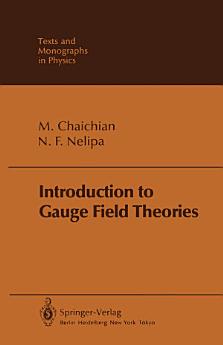Introduction to Gauge Field Theories
ທ.ວ. 2012 · Springer Science & Business Media
ປຶ້ມອີບຸກ
332
ໜ້າ
reportບໍ່ໄດ້ຢັ້ງຢືນການຈັດອັນດັບ ແລະ ຄຳຕິຊົມ ສຶກສາເພີ່ມເຕີມ
ກ່ຽວກັບປຶ້ມ e-book ນີ້
In recent years, gauge fields have attracted much attention in elementary par ticle physics. The reason is that great progress has been achieved in solving a number of important problems of field theory and elementary particle physics by means of the quantum theory of gauge fields. This refers, in particular, to constructing unified gauge models and theory of strong interactions between the elementary particles. This book expounds the fundamentals of the quantum theory of gauge fields and its application for constructing unified gauge models and the theory of strong interactions. In writing the book, the authors' aim was three-fold: firstly, to outline the basic ideas underlying the unified gauge models and the theory of strong inter actions; secondly, to discuss the major unified gauge models, the theory of strong interactions and their experimental implications; and, thirdly, to acquaint the reader with a rather special mathematical approach (path-in tegral method) which has proved to be well suited for constructing the quantum theory of gauge fields. Gauge fields are a vigorously developing area. In this book, we have select ed for presentation the more or less traditional and commonly accepted mate rial. There also exist a number of different approaches which are presently being developed. The most important of them are touched upon in the Conclusion.
ໃຫ້ຄະແນນ e-book ນີ້
ບອກພວກເຮົາວ່າທ່ານຄິດແນວໃດ.
ອ່ານຂໍ້ມູນຂ່າວສານ
ສະມາດໂຟນ ແລະ ແທັບເລັດ
ຕິດຕັ້ງ ແອັບ Google Play Books ສຳລັບ Android ແລະ iPad/iPhone. ມັນຊິ້ງຂໍ້ມູນໂດຍອັດຕະໂນມັດກັບບັນຊີຂອງທ່ານ ແລະ ອະນຸຍາດໃຫ້ທ່ານອ່ານທາງອອນລາຍ ຫຼື ແບບອອບລາຍໄດ້ ບໍ່ວ່າທ່ານຈະຢູ່ໃສ.
ແລັບທັອບ ແລະ ຄອມພິວເຕີ
ທ່ານສາມາດຟັງປຶ້ມສຽງທີ່ຊື້ໃນ Google Play ໂດຍໃຊ້ໂປຣແກຣມທ່ອງເວັບຂອງຄອມພິວເຕີຂອງທ່ານໄດ້.
eReaders ແລະອຸປະກອນອື່ນໆ
ເພື່ອອ່ານໃນອຸປະກອນ e-ink ເຊັ່ນ: Kobo eReader, ທ່ານຈຳເປັນຕ້ອງດາວໂຫຼດໄຟລ໌ ແລະ ໂອນຍ້າຍມັນໄປໃສ່ອຸປະກອນຂອງທ່ານກ່ອນ. ປະຕິບັດຕາມຄຳແນະນຳລະອຽດຂອງ ສູນຊ່ວຍເຫຼືອ ເພື່ອໂອນຍ້າຍໄຟລ໌ໄໃສ່ eReader ທີ່ຮອງຮັບ.






